Human liver mesenchymal stem/progenitor cells inhibit hepatic stellate cell activation: in vitro and in vivo evaluation
- PMID: 28583205
- PMCID: PMC5460523
- DOI: 10.1186/s13287-017-0575-5
Human liver mesenchymal stem/progenitor cells inhibit hepatic stellate cell activation: in vitro and in vivo evaluation
Abstract
Background: Progressive liver fibrosis leads to cirrhosis and end-stage liver disease. This disease is a consequence of strong interactions between matrix-producing hepatic stellate cells (HSCs) and resident and infiltrating immune cell populations. Accumulated experimental evidence supports the involvement of adult-derived human liver mesenchymal stem/progenitor cells (ADHLSCs) in liver regeneration. The aim of the present study was to evaluate the influence of ADHLSCs on HSCs, both in vitro and in vivo.
Methods: Activated human HSCs were co-cultured with ADHLSCs or ADHLSC-conditioned culture medium. The characteristics of the activated human HSCs were assessed by microscopy and biochemical assays, whereas proliferation was analyzed using flow cytometry and immunocytochemistry. The secretion profile of activated HSCs was evaluated by ELISA and Luminex. ADHLSCs were transplanted into a juvenile rat model of fibrosis established after co-administration of phenobarbital and CCl4.
Results: When co-cultured with ADHLSCs or conditioned medium, the proliferation of HSCs was inhibited, beginning at 24 h and for up to 7 days. The HSCs were blocked in G0/G1 phase, and showed decreased Ki-67 positivity. Pro-collagen I production was reduced, while secretion of HGF, IL-6, MMP1, and MMP2 was enhanced. Neutralization of HGF partially blocked the inhibitory effect of ADHLSCs on the proliferation and secretion profile of HSCs. Repeated intrahepatic transplantation of cryopreserved/thawed ADHLSCs without immunosuppression inhibited the expression of markers of liver fibrosis in 6 out of 11 rats, as compared to their expression in the vehicle-transplanted group.
Conclusions: These data provide evidence for a direct inhibitory effect of ADHLSCs on activated HSCs, which supports their development for the treatment of liver fibrosis.
Keywords: Hepatic stellate cells; Liver; Liver fibrosis; Liver stem/progenitor cells; Secretome.
Figures
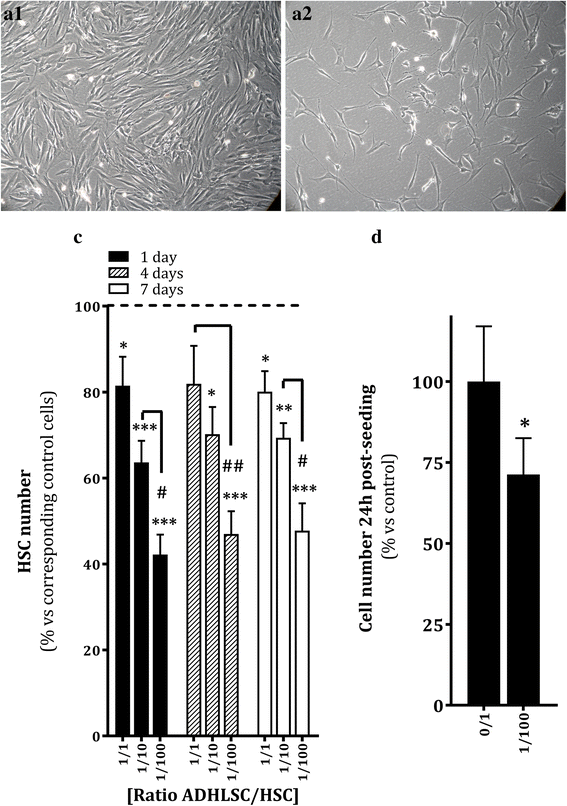
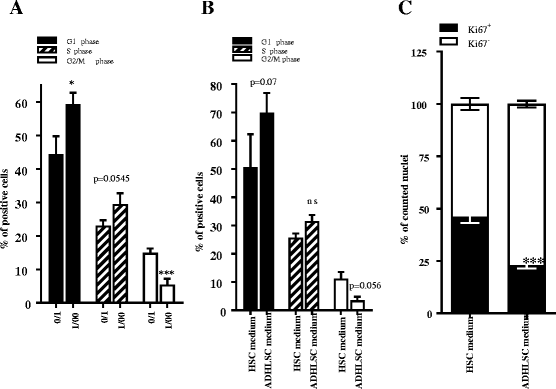
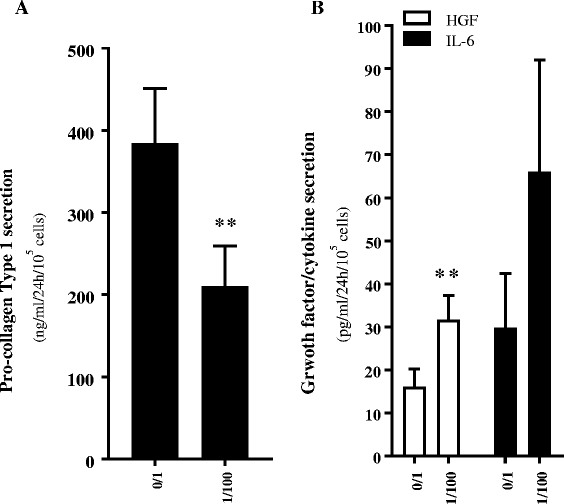
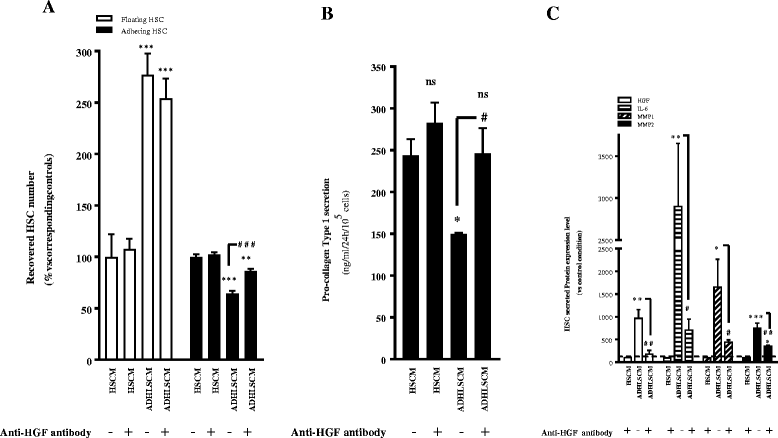
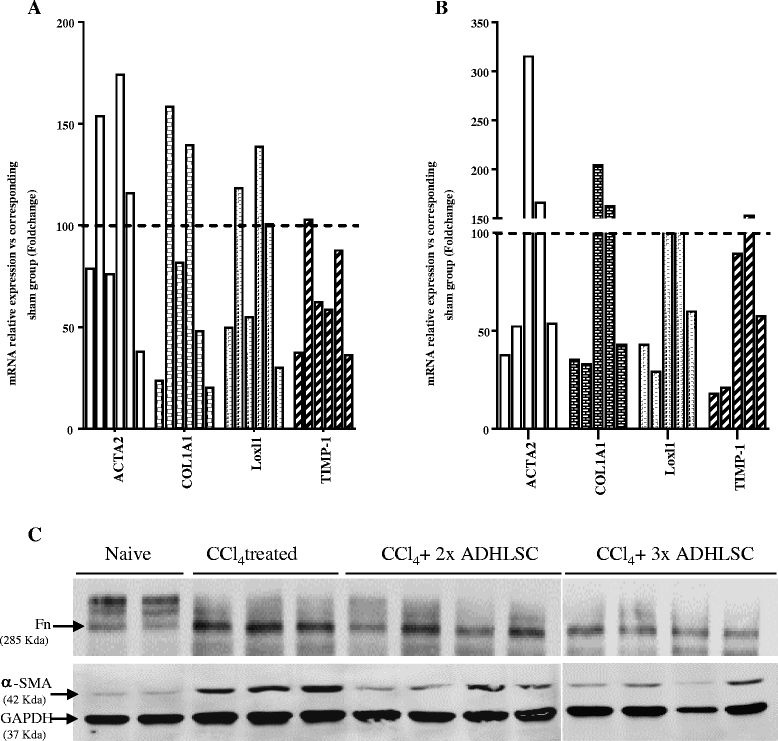
Similar articles
-
Adipose-derived mesenchymal stem cells inhibit activation of hepatic stellate cells in vitro and ameliorate rat liver fibrosis in vivo.J Formos Med Assoc. 2015 Feb;114(2):130-8. doi: 10.1016/j.jfma.2012.12.002. Epub 2013 Feb 8. J Formos Med Assoc. 2015. PMID: 25678175
-
Human umbilical cord-derived mesenchymal stem cells attenuate hepatic stellate cells activation and liver fibrosis.Mol Biol Rep. 2024 Jun 14;51(1):734. doi: 10.1007/s11033-024-09664-6. Mol Biol Rep. 2024. PMID: 38874773 Free PMC article.
-
In vivo hepatic differentiation potential of human umbilical cord-derived mesenchymal stem cells: Therapeutic effect on liver fibrosis/cirrhosis.World J Gastroenterol. 2017 Dec 14;23(46):8152-8168. doi: 10.3748/wjg.v23.i46.8152. World J Gastroenterol. 2017. PMID: 29290652 Free PMC article.
-
Wnt signaling in liver fibrosis: progress, challenges and potential directions.Biochimie. 2013 Dec;95(12):2326-35. doi: 10.1016/j.biochi.2013.09.003. Epub 2013 Sep 13. Biochimie. 2013. PMID: 24036368 Review.
-
Intercellular crosstalk of hepatic stellate cells in liver fibrosis: New insights into therapy.Pharmacol Res. 2020 May;155:104720. doi: 10.1016/j.phrs.2020.104720. Epub 2020 Feb 21. Pharmacol Res. 2020. PMID: 32092405 Review.
Cited by
-
Granulocyte colony-stimulating factor reduces biliary fibrosis and ductular reaction in a mouse model of chronic cholestasis.Liver Res. 2023 Mar 6;7(1):90-98. doi: 10.1016/j.livres.2023.02.004. eCollection 2023 Mar. Liver Res. 2023. PMID: 39959697 Free PMC article.
-
Human Allogeneic Liver-Derived Progenitor Cells Significantly Improve NAFLD Activity Score and Fibrosis in Late-Stage NASH Animal Model.Cells. 2022 Sep 13;11(18):2854. doi: 10.3390/cells11182854. Cells. 2022. PMID: 36139429 Free PMC article.
-
Liver Bioengineering: Promise, Pitfalls, and Hurdles to Overcome.Curr Transplant Rep. 2019 Jun;6(2):119-126. doi: 10.1007/s40472-019-00236-3. Epub 2019 Mar 25. Curr Transplant Rep. 2019. PMID: 31289714 Free PMC article.
-
A phase II study of human allogeneic liver-derived progenitor cell therapy for acute-on-chronic liver failure and acute decompensation.JHEP Rep. 2021 Apr 18;3(4):100291. doi: 10.1016/j.jhepr.2021.100291. eCollection 2021 Aug. JHEP Rep. 2021. PMID: 34169246 Free PMC article.
-
Applicability of adipose-derived mesenchymal stem cells in treatment of patients with type 2 diabetes.Stem Cell Res Ther. 2019 Aug 28;10(1):274. doi: 10.1186/s13287-019-1362-2. Stem Cell Res Ther. 2019. PMID: 31455405 Free PMC article. Review.
References
MeSH terms
Substances
LinkOut - more resources
Full Text Sources
Other Literature Sources
Medical
Miscellaneous

